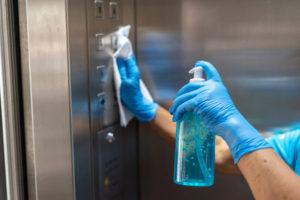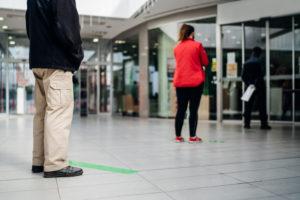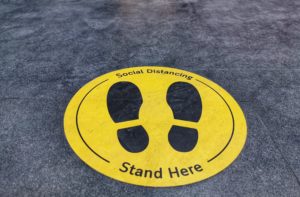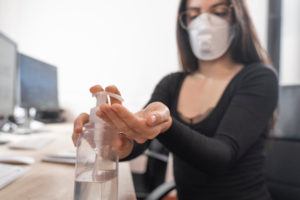Managing Risk at Work
The Risk Assessment and Risk Management Approach
Certain events will define moments in our lives. COVID-19 will certainly define an era in all of our lives.
At time of writing, we have seen 13.4m reported cases and 580,000 COVID-19 deaths across the world.* COVID-19 has spread around the planet, sending billions of people into lockdown.
The UK has operated in some form of lockdown for 16 weeks, which has had a huge impact on the economy, businesses and people’s everyday lives.
Managing risk at work
Millions have had to adjust to working from home, essential workers have put their lives on the front line, many parents have had to juggle working whilst home schooling, work and home life roles have become blurred, over 70s have self-isolated and businesses have had to adapt in the most challenging of times… in fact it’s hard to think of anyone whose lives have not been affected in some way by COVID-19.
As the lockdown starts to lift, we are moving into a new phase with organisations now navigating how best to get their people back to work with all eyes on the road to recovery. Now, more than ever, plans and expectations as a business need to focus on people, and how best they can help their people get back to work and keep them in work – safely.
The biggest responsibilities and challenges faced as an employer are making sure the workplace is COVID secure with a duty to perform a COVID-19 specific risk assessment.
Miller Health can support you with this challenge
What is the Risk Assessment Process?
As an employer, it is your legal duty to protect your employees and others from harm. Assessing that risk and putting actions in place to reduce that risk is a critical element of the overall process.
COVID has changed the way we work
More and more people are working from home, but that does not mean your responsibility as an employer changes. You still have the same health and safety responsibilities for home workers as for any other workers. It’s helpful to look at the HSE website as a good place to start, where they have a page dedicated to protect home workers outlining some of the key focus areas to take into consideration.
It’s not just for COVID
Whilst COVID-19 has changed the way we work, risk assessment and management of risk is not a new thing. It is a legal requirement that employers protect the health and safety of their employees, and COVID forms a part of this. That’s what Occupational Health is all about, our role is to keep people well at work, both physically and mentally.
The HSE Risk Assessment Process
The Health and Safety Executive’s 5-point Risk Assessment process is a good starting point, and one used throughout by Occupational Health.
- Identify the hazard
- Not all hazards are obvious and they will be unique to your workplace, and the types of risks are identified below under types of risk
- Assess the risk
- What level of risk is there? Employers need to assess the likelihood of the risk happening and the level of risk on a scale (high, medium or low for example)
- Identify who is at risk
- Identify who is at risk, including full, part-time, agency and contract staff and visitors including clients, customers and members of the public who visit your site
- Remove or control the risks
- Not all risks can be removed, but you need to work to control the risk so that the level of risk is reduced to where it can be, and that harm is unlikely
- Record the findings
- If you employ 5 or more people, you must record your significant findings
- Review the controls and adjust on a regular basis
- The risk review is not a static piece of work and needs to be reviewed regularly
The potential risks
HSE identifies the different types of risk as:
Physical – Physical hazards can be any factors within the environment that can harm the body without necessarily touching it such as noise, repetitive movements, working at heights, exposure to electricity, working in confined spaces and so on.
Chemical – Chemical hazards include working with chemicals or other toxic materials, and are present in many workplaces large and small, from major manufacturers to hairdressers and cleaners for example.
Biological – Biological hazards may include bacteria, viruses, birds, animals and humans, causing a variety of health issues from skin irritation through to infections. Biological hazards can be found in many workplaces including agriculture, laboratories, hospitals and building sites.
Ergonomic – Ergonomic hazards are a result of physical factors that then result in musculoskeletal injuries, such as how your workstation is set up. This is particularly relevant now with so many people home working.
Safety – These are hazards that create unsafe working conditions like working up a ladder without safety measures or exposed electrical wires at your place of work.
Social – these may affect workers’ psychological response to their work and workplace conditions. Examples include people who work in a customer services role with repeated calls from angry customers leading to stress and anxiety, or social isolation when working from home or undertaking increased shift work, which is particularly prevalent in this climate.
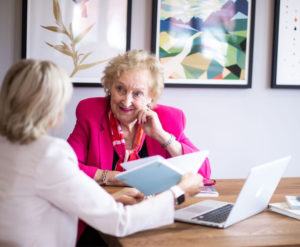
Businesses Need to Survive
Businesses need to survive – without your people you have no business. You must put people first in your plans for recovery:
Risk Assessment
- Undertake a full risk assessment of your workplace, (including the physical premises) and the people that work and visit there. Talk with the people in your business as they will provide valuable insights and a framework to help you evaluate the levels of risk faced.
- Identify, control and reduce risks before people return to work, this must include COVID-19 but also any other risks identified.
- Identify risk by individual person and job. Do their job roles put them at a higher risk of catching COVID-19? If so, what measures can you put in place to reduce this risk such as PPE.
- Identify whether any members of your team or their families have a letter from the NHS placing them at higher risk of COVID-19.
- Discuss how employees can best return to work. This needs to be done on an individual basis, considering their individual needs. Consider adjustments to hours of work and places of work and any other environmental adjustments such as a private office. Consider whether the employee may be able to return to work on a phased basis or full-time.
- If your employee remains working from home, you still have a legal duty of care when it comes to health and safety.
Get the right people for the right job
- This is not a job for an untrained person who has little knowledge of the way your business operates, get it wrong and your business could face hefty fines – or worse – the health of your people may be put at risk.
- Clinical assessments are best undertaken by Occupational Health, Risk Assessments are best undertaken by Business Risk Assessors with H.R. involvement – these are all people who are trained and understand the gravitas of the task and role ahead.
Communication
- It has been well documented that one of the major factors in business growth is reaffirming employee trust. The huge change has led to uncertainty, lack of job security, safety at work are just some of the factors that have reduced trust in the workplace. Your team need to know that you are doing your very best to keep them safe, and are following government guidelines when it comes to health and safety, ideally going above and beyond.
- Take a moment to reflect on what your people have gone through and how they are feeling, COVID has not just been an economic crisis but also a human crisis, ask people how they are feeling and really listen to their answers – take the time to understand how people have been directly affected by the coronavirus and whether you can help.
- Remember to share your business vision and mission so you can get people on board so that you can take the journey together to help them to feel engaged and valued.
A Case Study
A client recently came to me with a problem. An employee of theirs is within the high-risk category for COVID-19 but also very keen to continue working, which they did so successfully during the lockdown, adjusting work activities where appropriate. However as the lockdown has eased, they have become increasingly anxious about their return to work.
I spent time to understand the depth of this anxiety and reasons behind it in order to determine the best ways forward. A phased return to work was recommended with 2 short days a week in office with rest of the week working from home.
I followed up with support specifically around anxiety and mental health, including speedy counselling and potential referral to the Company Employee Assistance programme if the anxiety was found to be severe using a well-validated tool.
Line managers and Strategic HR were involved in supportive discussions, leading to the employee feeling listened to and valued.
We shared what the company are doing around risk assessments and all that they have put in place regards minimising the risk for all employees, with a special focus around those at higher risk. This played a big part in alleviating their concerns, knowing the business was taking their responsibilities seriously and that people really were the heartbeat of the organisation.
We mutually agreed a gradual return to full time work, with regular support and a platform for honest communication.
If you want the best in gaming and related information, then our sponsor, Slotogate, has you covered. Dive into their world of table games and slots, including classics and modern hits. Unlock exclusive bonuses and discover the safest casinos through their reviews like red dog casino reviews. Join Slotogate for an unforgettable gaming journey.
—————
Miller Health helps employers to meet their responsibilities and needs to assess and manage health risks. We support businesses to provide a safe place of work, promoting healthy workplaces, healthy people and a healthy and profitable business.
The approach of ‘we are all in this together’ is essential for success.

Please get in touch if I can help you or your team…
Doreen Miller
Tel: +44 (0)333 900 9280
Email: [email protected]
millerhealth.com
* World Health Organization – Friday 17th July 2020


